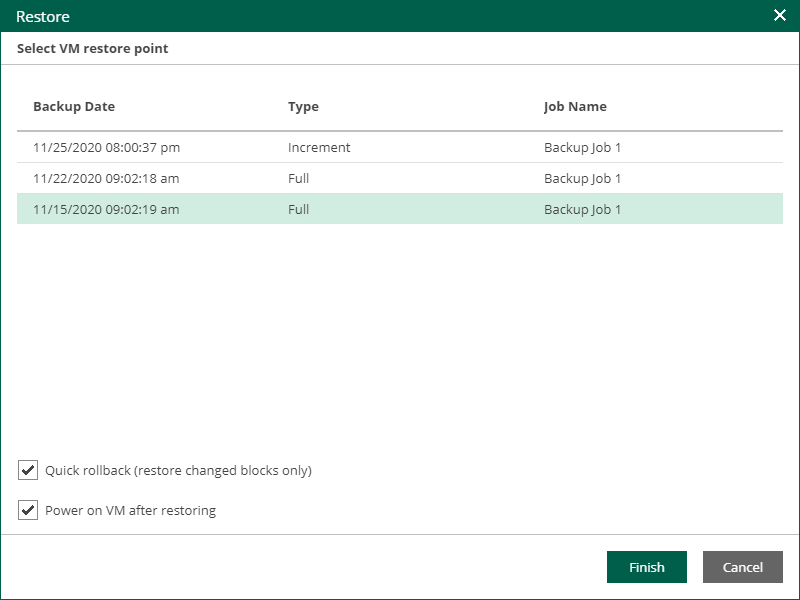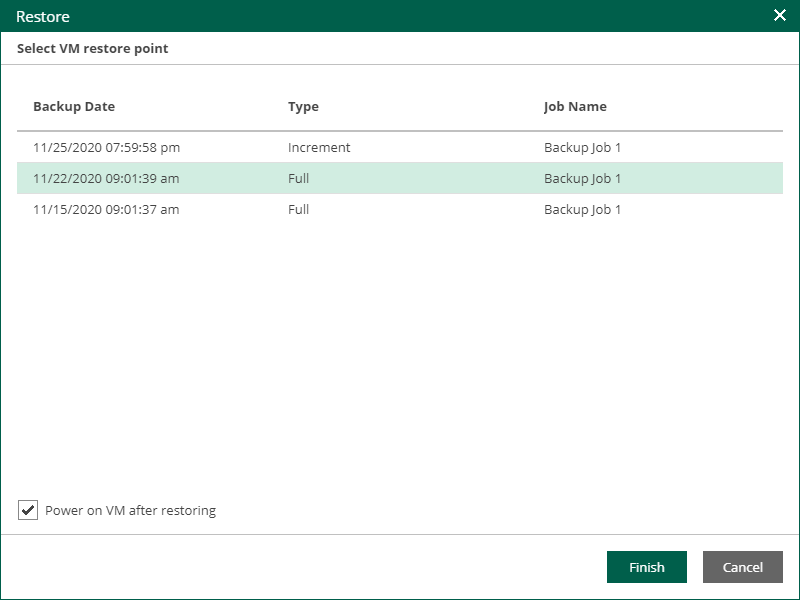 This is an archive version of the document. To get the most up-to-date information, see the current version.
This is an archive version of the document. To get the most up-to-date information, see the current version.Managing vCD VMs and vApps
On the VMs tab, members of the vCD organization can perform the following tasks:
- Browse VMs and vApps
- Restore VMs
- Restore vApps
- Restore VM disks
- Delete VMs and vApps from Backups
Note |
With Veeam Self-Service Backup Portal, you can restore VMs and vApps to the original location only. You can restore them to another location or with different settings using the Veeam Backup & Replication console. For more information, see the Restore of vCloud Director VMs section of the Veeam Backup & Replication User Guide. |
You can restore vCD VMs to the original (production) vApp.
To restore a VM:
- On the VMs tab, select the necessary VM backup in the list of VMs. To quickly find the necessary VM, use the search field at the top of the window.
- Click Restore VM and select the option you need:
- Select Overwrite to restore the VM from the backup to the original vApp, replacing the production VM.
In this case, the restored VM hard disks are assigned the storage policies of the original VM hard disks.
- Select Keep to keep both VMs in the original vApp. The VM from the backup will be located next to the original production VM and will have the same name with the _restored suffix.
In this case, the restored VM hard disks are assigned the storage policy of the VM.
- Select the restore point that will be used to restore the VM.
- [Optional] Instead of restoring an entire machine from a backup file, you can instruct Enterprise Manager to recover only those data blocks that are necessary to revert the machine to the selected restore point. To do this, select the Quick rollback check box. Quick rollback significantly reduces the recovery time and has little impact on the production environment.
For more information on quick rollback, see the Quick Rollback section of the Veeam Backup & Replication User Guide.
- [Optional] To start a machine immediately after recovery, select the Power on machine after restoring check box.
- Click Finish.
- Click Yes in the message window to confirm the operation.
To view the VM restore progress, on the Machines tab, click History.
Important |
Restore of a standalone VM to the original location with the Keep option selected results in an unpredictable behavior and possible failure of the restore job. |
You can restore a vApp to the original VDC.
To restore a vApp:
- On the VMs tab, select a vApp. To quickly find the necessary vApp, use the search field at the top of the window.
- Click Restore vApp and select the option you need:
- Select Overwrite if you want to restore the vApp from the backup to the original VDC, replacing the production vApp.
- Select Keep if you want to keep the original vApp in the original VDC. The vApp from the backup will be located next to the original production vApp and will have the same name with the _restored suffix. Names of VMs in the vApp will remain the same.
- Select the restore point that will be used to restore the vApp.
- [Optional] To start VMs in the restored vApp immediately after recovery, select Power on VM after restoring.
- Click Finish.
- Click Yes in the message window to confirm the operation.
To view the VM restore progress, on the Machines tab, click History.
Important |
Restore job of a vApp with a standalone VM will return an ordinary and not standalone VM. |
You can restore individual virtual disks from backups of vCloud Director VMs.
To restore a virtual disk:
- On the VMs tab, select a VM with disks you want to restore. To quickly find the necessary VM, use the search field at the top of the window.
- Click Virtual Disks.
- Follow the steps of the Virtual Disk Restore wizard. For details, see Performing Virtual Disk Restore.
Deleting VMs and vApps from Backups
You can delete a VM from the vApp. If the selected VM is the last one in its vApp, the VM will be deleted from the backup with its vApp. If this vApp is the last one in its backup, the whole backup will be deleted.
If you delete a VM that has GFS backups, they will not be deleted. You can delete them in Veeam Backup Enterprise Manager. For more information, see Deleting Machine from Backups.
To delete a VM:
- On the VMs tab, select a VM. To quickly find the necessary VM, use the search field at the top of the window.
- Click Delete.
- Click Yes to confirm the deletion.
When you remove data for deleted VMs from per-VM backup chains, it does not mark the space as available but deletes backup files since they contain data for one VM only.
When you remove data for deleted VMs from regular backup chains, the space is not freed up on the backup repository. It is marked as available to be overwritten, and this space is overwritten during subsequent job sessions or the backup file compact operation.

